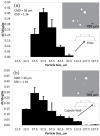A Simple and Disposable Sampler for Inhalable Aerosol
- PMID: 26467335
- PMCID: PMC4763335
- DOI: 10.1093/annhyg/mev065
A Simple and Disposable Sampler for Inhalable Aerosol
Abstract
The state-of-the-art for personal sampling for inhalable aerosol hazards is constrained by issues of sampler cost and complexity; these issues have limited the adoption and use of some samplers by practicing hygienists. Thus, despite the known health effects of inhalable aerosol hazards, personal exposures are routinely assessed for only a small fraction of the at-risk workforce. To address the limitations of current technologies for inhalable aerosol sampling, a disposable inhalable aerosol sampler was developed and evaluated in the laboratory. The new sampler is designed to be less expensive and simpler to use than existing technologies. The sampler incorporates a lightweight internal capsule fused to the sampling filter. This capsule-filter assembly allows for the inclusion of particles deposited on the internal walls and inlet, thus minimizing the need to wash or wipe the interior sampling cassette when conducting gravimetric analyses. Sampling efficiency and wall losses were tested in a low-velocity wind tunnel with particles ranging from 9.5 to 89.5 μm. The results were compared to the proposed low-velocity inhalability criterion as well as published data on the IOM sampler. Filter weight stability and time-to-equilibrium were evaluated as these factors affect the practicality of a design. Preliminary testing of the new sampler showed good agreement with both the IOM and the proposed low-velocity inhalability curve. The capsule and filter assemblies reached equilibrium within 25h of manufacturing when conditioned at elevated temperatures. After reaching equilibrium, the capsule-filter assemblies were stable within 0.01mg.
Keywords: air pollution; exposure; low cost; particulate matter; sampling efficiency; wall deposits.
© The Author 2015. Published by Oxford University Press on behalf of the British Occupational Hygiene Society.
Figures





Similar articles
-
Review of Workplace Based Aerosol Sampler Comparison Studies, 2004-2020.Int J Environ Res Public Health. 2021 Jun 25;18(13):6819. doi: 10.3390/ijerph18136819. Int J Environ Res Public Health. 2021. PMID: 34202035 Free PMC article. Review.
-
Performance of personal inhalable aerosol samplers in very slowly moving air when facing the aerosol source.Ann Occup Hyg. 2004 Jun;48(4):351-68. doi: 10.1093/annhyg/meh006. Epub 2004 Mar 2. Ann Occup Hyg. 2004. PMID: 15191944
-
Evaluation of a 25-mm disposable sampler relative to the inhalable aerosol convention.J Occup Environ Hyg. 2019 Sep;16(9):634-642. doi: 10.1080/15459624.2019.1632463. Epub 2019 Jul 12. J Occup Environ Hyg. 2019. PMID: 31298629
-
Laboratory study of selected personal inhalable aerosol samplers.Ann Occup Hyg. 2010 Mar;54(2):165-87. doi: 10.1093/annhyg/mep079. Epub 2010 Feb 10. Ann Occup Hyg. 2010. PMID: 20147627
-
New experimental methods for the development and evaluation of aerosol samplers.J Environ Monit. 2002 Oct;4(5):633-41. doi: 10.1039/b202274p. J Environ Monit. 2002. PMID: 12400907 Review.
Cited by
-
Review of Workplace Based Aerosol Sampler Comparison Studies, 2004-2020.Int J Environ Res Public Health. 2021 Jun 25;18(13):6819. doi: 10.3390/ijerph18136819. Int J Environ Res Public Health. 2021. PMID: 34202035 Free PMC article. Review.
-
Evaluation of total and inhalable samplers for the collection of carbon nanotube and carbon nanofiber aerosols.Aerosol Sci Technol. 2019;53(8):958-970. doi: 10.1080/02786826.2019.1618437. Epub 2019 May 30. Aerosol Sci Technol. 2019. PMID: 35392279 Free PMC article.
-
Laboratory evaluation of a low-cost, real-time, aerosol multi-sensor.J Occup Environ Hyg. 2018 Jul;15(7):559-567. doi: 10.1080/15459624.2018.1468565. J Occup Environ Hyg. 2018. PMID: 29683781 Free PMC article.
-
Performance of prototype high-flow inhalable dust sampler in a livestock production facility.J Occup Environ Hyg. 2017 May;14(5):313-322. doi: 10.1080/15459624.2016.1240872. J Occup Environ Hyg. 2017. PMID: 27792469 Free PMC article.
-
Near-Patient Sampling to Assist Infection Control-A Case Report and Discussion.Int J Environ Res Public Health. 2018 Jan 31;15(2):238. doi: 10.3390/ijerph15020238. Int J Environ Res Public Health. 2018. PMID: 29385031 Free PMC article.
References
-
- Aerosol-Technology-Committee. (2011) The state of the science of inhalable particles. A Science Symposium. American Industrial Hygiene Conference and Exposition. Portland, OR.
-
- Aitken RJ, Baldwin PEJ, Beaumont GC, et al. (1999) Aerosol inhalability in low air movement environments. J Aerosol Sci; 30: 613–26.
-
- Ameille J, Wild P, Choudat D, et al. (1995) Respiratory symptoms, ventilatory impairment, and bronchial reactivity in oil mist-exposed automobile workers. Am J Ind Med; 27: 247–56. - PubMed
-
- Baldwin PEJ, Maynard AD. (1998) A survey of wind speeds in indoor workplaces. Ann Occup Hyg; 42: 303–13. - PubMed
-
- Balmes J, Becklake M, Blanc P. (2003) Occupational contribution to the burden of airway disease (an official statement of the American Thoracic Society). Am J Respir Crit Care Med; 167: 787–97. - PubMed
Publication types
MeSH terms
Substances
Grants and funding
LinkOut - more resources
Full Text Sources
Other Literature Sources

